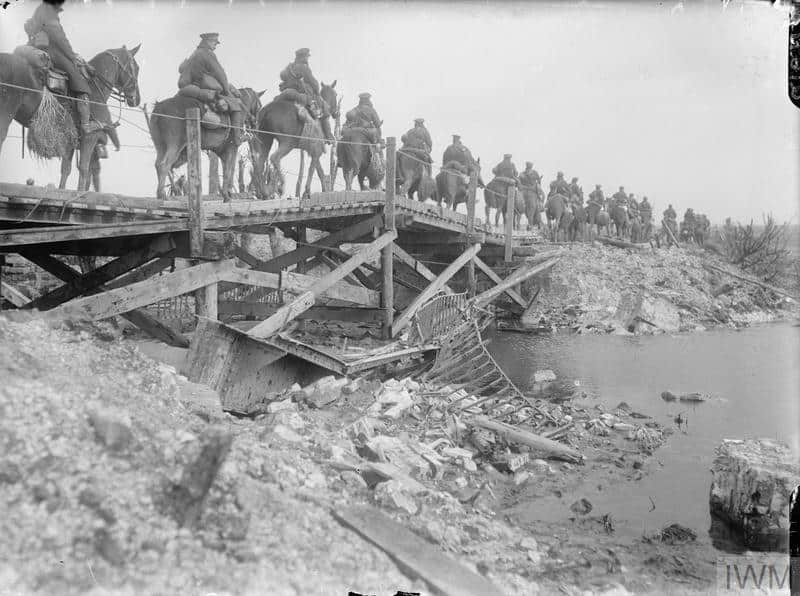Mons
The Battle of Mons was the first major action of the British Expeditionary Force in the First World War. It was a subsidiary action of the Battle of the Frontiers, in which the Allies clashed with Germany on the French borders.
The Honour was awarded to the 3rd Hussars.
Detail
The night of the 18th found the 3rd Hussars on the move, Headquarters and ‘A’ Squadron entraining at 8.35 pm, and ‘B’ Squadron and the machine guns at 12.40 pm. The first train left about midnight and arrived at their destination, Hautmont, about 1 pm the next day. miens and Busigny were passed en route.
After detraining at Hautmont horses were watered and fed, and then they marched to Solre le Chateau, which had been given the Regiment as its billeting area. A twelve miles’ march brought them there, but the place was already occupied by the XVIII French Corps. On the march back it was discovered that the billeting area had been changed to Wattignies.
It was expected to remain a few days in Wattignies, but at 10.30 pm on the 20th orders arrived for a move forward early next morning. ‘C’ Squadron had not yet joined.
The 4th Cavalry Brigade was composed of:
- Commanding, Brigadier-General the Hon. C.E. Bingham,
- Household Cavalry (Composite Regiment),
- 6th Dragoon Guards (Carabiniers),
- 3rd King’s Own Hussars.
At 06.05am on the 21st theBrigade concentrated at Wattignies. A troop of ‘A’ Squadron marched as an advance guard until touch with the 2nd Cavalry Brigade, who was leading, was obtained. Soon after, turning north-west, the brigade rode along the Mons road to Rouveroy, which was reached at noon. After a short stay, the brigade was on the move again.
The brigade moved to Harminnies in support of the 1st, 3rd and 5th Cavalry Brigades, covering the march of our infantry. Hostile cavalry had been reported advancing in force on Mons from the direction of Nivelles. At dark, the 3rd moved into billets some three miles west in the chateau at Harveng, while the other two regiments went into the villages.
The Regiment was saddled up and ready at 4 am on the 22nd, but it was not until 11.20 am that the squadrons moved to the brigade starting point. The 3rd, as the leading regiment had sent out ‘B’ Squadron as an advanced guard when Cavalry division orders arrived cancelling the march west to Quievrain and ordering the brigade to move in support of the other brigades who were in contact with the enemy.
The Brigade rode in the direction of Binche and Bray and took up its position at the “Halte” for the rest of the day. At 7 pm the 3rd withdrew from”Halte” and then followed a long weary march of some twenty miles through a thickly populated manufacturing district.
It was nearly 1 in the morning of the 23rd when the Regiment reached its billeting area at Baisieux. At the time nothing was known but the Brigade was on the Conde canal with some of the Carabiniers on its farther side. As a matter of fact, the 2nd and 4th Cavalry Brigades were holding the line of that canal, the 2nd in touch with the 5th Infantry Division on the right with the 1st and 3rd Cavalry Brigades in support.
At about 5 pm the 3rd found themselves again crossing the frontier, and reached the French village of Saultain a couple of hours later. At 4 am the next day, the 24th, the Regiment marched eastwards, ‘C’ Squadron being detached to Valenciennes on a special reconnaissance.
It was not until 1 pm that the Brigade left Sebourg and marched to Preseau, the 3rd finding an advanced guard squadron, and detaching the third squadron to protect the right flank of the 11th Infantry Brigade marching south to Jenlain. ‘C’ Squadron reported a large force of Uhlans advancing on Valenciennes from the northeast, so back the brigade went to Saultain.
At dusk, the Brigade was ordered to hold the line Saultain-Curgies-Jenlain. The 3rd was allotted the portion Curgies-Fort Curgies and connected with the Composite Regiment at Sautain. The position was put in a state of defence, posts facing northeast being established along the railway embankment and the main road being blocked at either end of the village.
‘A’ and ‘B’ Squadrons were in the front line, with ‘C’ in support at the fort a quarter of a mile south of the village. The Regiment had been told to “hold on” in the event of an attack, and the squadrons remained on the alert throughout the night.
The news came through that in the early morning the Germans had commenced their attack on the British position west of Mons; that the cavalry had held on and enabled the infantry to retire.
The Regiment was ordered to retire at 4.30 am on the 25th, just as German infantry were seen coming up through the corn-stacks to the attack. The squadrons collected at the fort and then moved southwest to join the brigade concentration at Maresches.
Covered by its rear-guard of cavalry, the British Army continued its retirement.


